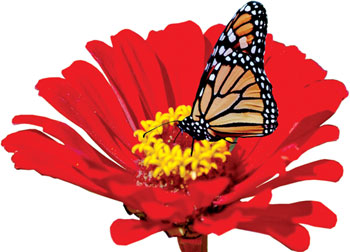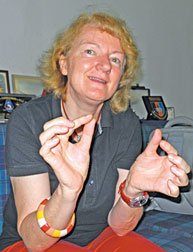Palynology can help solve crime
By Dhaneshi YATAWARA
 |
|
Pollen is dispersed by
insects such as butterflies |
Wherever a criminal steps, whatever he touches and whatever crime he
commits, he will leave unconsciously 'marks' that will serve as a silent
witness against him. According to the Locard exchange principle
theorised by 20th century forensic scientist Edmond Locard, "with
contact between two items, there will be an exchange - in short - every
contact leaves a trace." This trace can be as minute as a pollen. Can
pollen act as hard evidence in forensics?
The study of pollen called palynology appears to be a technique few
people know about and even fewer utilise. The full potential of forensic
palynology remains untapped in most countries. Though minute in size,
pollen can be a major factor leading detectives to the actual killer in
a murder case.
"Because of the differences in the pollen wall, we can identify and
differentiate pollen up to the genus and family level in plant
classification, and in certain instances even up to the species level,"
said Professor Martina Weber of the University of Vienna, Austria.
Prof. Weber was on a brief visit to Sri Lanka recently to train Sri
Lankan botanists and forensic scientists on the advancement of
palynology.
It is difficult to establish precisely when the field of forensic
palynology took root. One of the earliest reported cases using forensic
palynology was in 1959 in Austria. Prof. Weber explained this
significant episode that triggered a new wing in forensic sciences. The
story is as follows:
A man disappeared near Vienna during a vacation along the Danube
River, but his body could not be found. The police soon found a suspect
who had a motive for killing the person, but had no evidence to link the
suspect with the crime.
Mud on boots
A search of the suspect's room revealed a pair of boots with mud
still on the soles. These were taken as evidence and given to Wilhelm
Klaus, a geologist with the Austrian Geological Survey, for analysis.
Dr. Klaus examined the mud and found that it contained modern spruce,
willow, and alder pollen. There was also a special type of 20
million-year-old, Miocene-age fossil of hickory pollen grain present in
the mud sample.
 |
|
Electron microscopic
image of a pollen grain from a daisy |
Based on the pollen evidence, Dr. Klaus was able to pinpoint the area
where the defendant must have walked in while getting mud on his boots.
Only one location, a small area 20 kilometres north of Vienna along the
Danube Valley, had soil that contained the precise mixture of pollen
found in the mud on the boots.
When confronted with the identity of this location, the shocked
defendant confessed his crime and showed the authorities where he had
killed the victim and buried the body, both of which had taken place in
the precise region pinpointed by Klaus.
What makes pollen hard evidence in critical cases? Pollen carries the
male gametes of flowering plants to a suitable pistil of another plant
while protecting the male cells during the journey. The outer pollen
wall is made of a very stable material called sporopollenin which
protects the gametes inside.
"Sporopollenin can survive for millions of years when concealed in
fossils. Yet the chemical composition of sporopollenin is still not
known.
ďAnd we still do not know why it is that durable and can survive
millions of years if enclosed in fossils," Prof. Weber said.
Soil, dirt, and dust are common elements at almost every crime scene.
Therefore, they should be collected carefully because often these
elements are abundant in pollen. Samples of dirt collected from the
crime scene may prove useful in linking it to the location where the
crime took places. The same would be true of any suspects thought to be
associated with a crime.
How is this done?
The first task of the forensic palynologist is to try to find a match
between the pollen in a known geographical region with the pollen in a
forensic sample. Knowledge of pollen dispersal and productivity often
plays a major role in solving such problems.
First, if one knows what the production and dispersal patterns of
pollen are for the plants in a particular region, then one would know
what type of "pollen fingerprint" to expect in samples from that area.
 |
|
Professor Martina Weber |
There are a number of different methods by which plants disperse
their pollen. In a larger group of plants pollination is dependent on
the transport of pollen by insects (i.e., bee, wasp, beetle, butterfly,
moth, ant) or other animals (i.e., hummingbirds, lizards, nectar-feeding
small mammals). The potential value of such types of pollen in forensic
work is higher as these pollen grains have more durable outer walls than
pollen grains dispersed by other methods, such as by wind.
Such pollen gives the scientists a high degree of confidence that the
pollen belongs to the forensic sample and is not an atmospheric
contaminate. However, the constraint is so little pollen is produced by
each plant that the chances of its pollen getting into a forensic sample
are reduced.
The last category is the wind-pollinated plants. This group includes
a wide range of plants producing seeds. Because wind pollination is the
most inefficient method of seed dispersion, these plants must produce
vast quantities of lightweight grains that will travel easily in air
currents.
Pollen traps
Woven cloth, woollen blankets, ropes, clothing and fur all make
excellent traps for pollen and spores as woven materials and fur are
made of tiny interwoven fibre. When air comes in contact with woven
materials, the fibre become filters that retain solid particles. Human
and animal hair remains one of the best pollen traps.
When wind blows through hair, pollen in the wind becomes trapped in
the open spaces between individual hair strands. In humans, the addition
of various hair sprays, natural oils, and tonics makes hair surfaces
sticky and provides an even better trap for pollen and spores.
Fur rugs found at a crime scene may have been used for wiping shoes
and thus may be rich in pollen and spores.
Domestic pets, sheep, cattle, horses, or other fur-bearing animals
that might be associated with a crime scene or might be stolen or lost
may be traced to their original owner through the analysis of pollen and
spores attached to their hair.
Hair on fur coats, felt hats or sheep skins sometimes used as car
seat covers are also excellent pollen traps and should be considered for
their potential use as forensic samples.
 |
|
Electron microscopic image of a
fossilised rhododendran pollen grain |
One final concern is the amount of material that will be collected
for forensic analysis. In most cases, very little dirt, mud or other
debris is available for collection and analysis. Therefore, most
forensic palynologists face several immediate problems.
Yet another concern is access to pollen and spore reference
collections. Because there are hundreds or even thousands of potential
plant taxa that could exist in any forensic sample, precise
identification of pollen types is often time-consuming.
Like any other evidence, it is critical that a palynologist is able
to state that the materials, and the subsequent pollen samples collected
from those materials, were stored in a locked and secure location.
Forensic palynology is still in its infancy. There are only a few
pollen analysts in the world who have had forensic training or
experience; there are even fewer who might be willing to work on
forensic pollen samples.
It remains untried in many regions of the world, and is seldom used
in others. Yet palynologists believe that the next decade will become a
"trial" period for forensic palynology.
|

